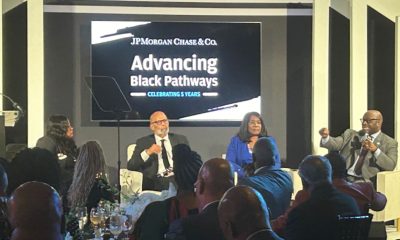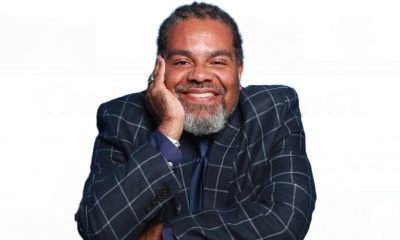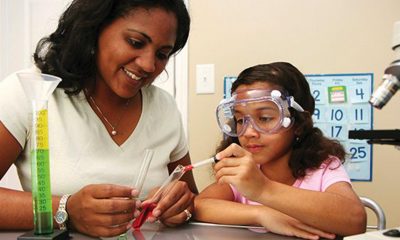National
Students of Color Now Matches White School Enrollment

By Jazelle Hunt
NNPA Washington Correspondent
WASHINGTON (NNPA) – As the nation’s families head back to school, they may notice that for the first time, elementary and middle school students of color will equal the percentage of White students, according to Department of Education projections.
White student enrollment has steadily declined, as have birth rates among White families. Hispanic-American students have, and will continue to have, the largest presence in public elementary and middle schools. Asian and multiracial student populations have also grown in that time, although much more modestly.
In recent years, Black public school enrollment has remained steady at around 17 or 18 percent of all students. It began to decline in 2006, falling to 15.3 percent of all K-8 public school students in 2011. That’s the most recent actual enrollment data from the National Center for Education Statistics (NCES); but the Department of Education predicts Black enrollment continued to decline in 2012 and 2013, will plateau for the next few years, and will begin rising again in 2017.
This year’s “majority-minority” demographic shift is speculation for now – the Department of Education won’t have the actual enrollment figures for fall 2014 until at least 2016. Still, it is a matter of when – not if – schools will be the first sector of society to reflect changing American demographics.
But it doesn’t seem as though public education is in-step with the nation’s steady transformation.
“What’s concerning to me as a consultant is that we have an increasing student population of color and declining percentages of teachers of color,” says Jawanza Kunjufu, a Chicago-based education consultant and author. “Unfortunately, most school districts have one to three days of training for teachers, and most of that is not around multicultural training.”
Less than 7 percent of the nation’s public school teachers are Black. Taken together, teachers of color are only 18 percent.
Kunjufu says that some university education programs, particularly those in urban areas, are attempting to prepare incoming, mostly-White teachers for classroom diversity. But this alone may not be enough to create effective schools that reflect their students.
“We’re looking at 2014 when students are going to be 50 percent White and 50 percent nonwhite, but the curriculum is still Eurocentric. The learning styles are still more left-brained. We still have tracking – the AP, honors, Gifted and Talented, and IB classes are still predominantly White and Asian,” he explains.
Discrimination also remains a problem, despite increased diversity. In fact earlier this year, the Department of Justice stepped in to issue a set of school disciplinary policy guidelines in line with civil rights law. The guidelines were in response to widespread suspensions of Black students of all ages, and also in response to increased law enforcement in school settings.
Under-qualified teachers often end up in Black and brown schools, the same schools that are often underfunded. And there aren’t enough teachers to go around for English-language-learning (ELL) students. In 2012 there were 4.4 million public school students enrolled in ELL programs, or 9.2 percent of all kids. There are only 51,000 ESL/bilingual elementary school teachers—or, a national ratio of one bilingual teacher for every 86 ELL students.
The demographic changes that are now colliding to create this student body shift have been brewing for years.
According to the Pew Research Center, Latinos have been the largest non-White population since 2002, and have continued to increase by 36 percent since then. At the same time, Asians are on par with Latino in terms of growth rate. Between 2012 and 2013, 61 percent of the growth in Asian population was attributed to immigration. In recent years, the growth in Latino population has been from births, not immigration; there have been 9.6 million births from 2000 to 2010, and first-generation Latino-Americans are now becoming adults.
Additionally, public school closures in Black and brown communities are a factor. As student populations are merged across differing communities, the demographics at these schools are significantly altered. These closures have given rise to charter schools. Since the 2001-2002 school year, the number of charter schools has nearly tripled, according to NCES data.
It is worth noting, however, that public charters are only 5.7 percent of all public schools and 4.2 percent of all public school enrollment, as of 2012. On a related note, the student body at private schools remains largely White at nearly 72 percent in 2011 (although pre-K through eighth grade private school enrollment has been on a slow decline since 2002, for all races).
The Department of Education has a few efforts to recruit more teachers of color, particularly through public-private partnerships. It has also taken steps to create state-based teacher training program evaluations.
“We want to recruit that next generation of talent into education…. We also want to make sure that we’re not just bringing great talent, but bringing talent from a diversity of backgrounds,” says Education Secretary Arne Duncan, in a February video address. “Increasingly our teachers and administrators don’t reflect the great diversity of our nation’s public schools. And we’re working very hard to bring more Black and Latino teachers – particularly men – into the profession.”
Kunjufu says that in his experience, efforts to incentivize and recruit teachers on the basis of race are often blocked by unions, though unions often support these tactics for teachers who specialize. In lieu of this aggressive recruiting, Kunjufu’s book, Black Students: Middle Class Teachers, advises schools to compensate for the cultural gap through professional development workshops on bonding, raising expectations, and using culturally relevant tools and methods.
“It’s frustrating for me because I’m primarily working with White, middle class, female teachers who did not grow up in communities of color, have not taken and multicultural courses, and are now teaching our children,” he says. “And it’s frustrating for them as well because they’re not being prepared. Yet, there seems to be resistance to making education more multicultural.”
###













































